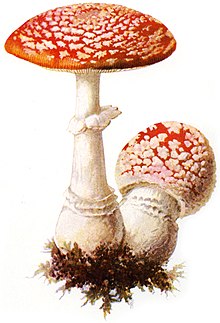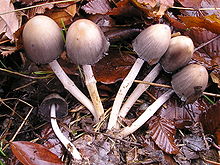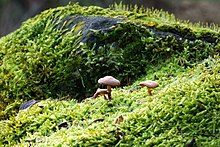Toadstool
As poisonous mushrooms are large mushrooms called - so larger species, mostly with hat and stick, in contrast to molds - which include self-generated substances whose consumption can cause human health damage and even death. A reliable distinction between toadstool and edible mushrooms is particularly important when collecting mushrooms .
If only harmful substances are introduced from the outside (e.g. heavy metals , pesticides or radioactive substances ), edible mushrooms do not become poisonous, even if they are inedible in individual cases.
Toxicity
overview
In Europe, of the approximately 5000 large mushrooms, about 150 species are known to be poisonous. Only a few species are actually life-threateningly poisonous. The most dangerous and most famous Toadstool is the Green Death Cap ( Amanita phalloides ). The orange fox head ( Cortinarius orellanus ) and the pointed hunched head ( Cortinarius rubellus ) are also deadly poisonous . Since many of the culinary worthless, smaller mushroom species have not yet been adequately investigated, it can be assumed that there are still many undiscovered poisonous mushrooms.
The following genera are particularly common toadic mushrooms: hair veils , capes , cracked mushrooms , red rot , velvet caps , umbrella , funnel-shaped and amanita . Among the relatives of the boletus , formerly known as boletus, there are - at least among those described so far - only a few species that are identified as poisonous or dangerous, including the Satan's boletus , but none that are fatally poisonous. If at all, these are gastrointestinal poisonous and cause corresponding complaints, which in individual cases can also be quite severe.
→ See also: List of poison mushrooms
Few mushrooms , like the wrinkle ink, have a poisonous effect even after three days if you also drink alcohol .
Some fungi contain mutagenic substances that do not cause acute symptoms of poisoning, but can lead to genetic damage over a long period of time . An example of this is the white tufted rasp .
Remarkably, toadstool mushrooms can serve as food for many snails , insects and many other animals without harm. For example, death cap mushrooms are often attacked by fungal flies .
Mushrooms that are not poisonous for every consumer
Some species are only poisonous to a few people. One of these species is the bald curled hair ( Paxillus involutus ), which some people tolerate well for years, but which can eventually trigger an allergic shock . Nevertheless, this mushroom is still often eaten in parts of Germany and also in Eastern Europe. Although many people consume it for years without harm, its toxicity is clearly demonstrated by an antigen that leads to the formation of antibodies in the blood. Therefore it has long been removed from the list of edible mushrooms. Another example is the green body ( Tricholoma equestre ), which in rare cases with a corresponding genetic predisposition can cause muscle weakness ( rhabdomyolysis ) leading to death .
People also react very individually to the spring lobster ( Gyromitra esculenta ), which is officially classified as a toadstool, but is valued as a tasty mushroom in northern and eastern Europe after appropriate preparation (repeated boiling and discarding the cooking water). Here, the same meal can have absolutely no effect on one person and cause light to severe symptoms of poisoning in another.
Contact poison
In Europe there is no known mushroom whose touch alone leads to poisoning, in contrast to some poisonous plants such as the blue monkshood . Even of the most dangerous poisonous mushrooms, at least a small sample must be consumed to cause poisoning.
Contradicting information on toxicity
For some types of mushrooms, there are contradicting information about their consumption value or toxicity. Individual intolerances are assumed to be the cause, which were then generalized without being examined. Examples:
- Fog cap ( Clitocybe nebularis ): The information varies from author to author and from country to country. In the United States it is generally considered poisonous, in France it is a popular edible mushroom, in Germany there is widespread disagreement. Raw this mushroom is definitely poisonous, cooked it is probably tolerated by some people, but not by others. Therefore, one should forego its enjoyment, especially since its taste value is not particularly great.
- Net-handled witch boletus ( Suillellus luridus ): Raw it is definitely poisonous. For cooked or fried mushrooms, the spectrum of information on edibility ranges from “very good” to “toxic with simultaneous consumption of alcohol” to “toxic”. If you do not want to do without this sometimes rich mushroom, you should heat or boil it vigorously for at least twenty minutes and if possible do not consume alcohol with the meal. As a precaution, its consumption should be avoided.
- Mica ink ( Coprinellus micaceus ): It is closely related to the wrinkle ink , which is toxic when mixed with alcohol. However, a similar connection has not yet been observed in the case of mica ink, in spite of other literature. Conclusion: edible.
A special case of raw mushrooms
A large number of fungi contain haemolysins (= blood-dissolving substances) and other heat-labile toxic substances. They are therefore more or less toxic in their raw state. These are traditionally not counted among the poisonous mushrooms, as mushrooms - with a few exceptions - should generally be eaten well cooked or fried. In the case of wild mushrooms, if they are not heated sufficiently, there is also a risk of infection with the fox tapeworm .
Among the raw poisonous mushrooms are particularly many well-known edible mushrooms such as Maronenröhrling , Armillaria , blusher and Parasol . Cultivated mushrooms such as oyster mushrooms or shiitake should also be heated before consumption.
Behavior towards unknown species

Before an unknown mushroom is used for consumption, it should at least be determined by a proven expert ( mushroom advice center ).
Children should not take part in "experimental" or trial tastings of not clearly known mushroom meals, as children would be particularly at risk in the event of poisoning due to their lower body weight and growing organs.
"Rules of thumb" and popular tips - such as the discoloration of a silver spoon when you cook it - are in no way suitable for recognizing poisonous mushrooms and are therefore considered gross negligence. For example, a silver spoon will not discolour when cooking tuber mushrooms.
Mushroom poisoning
Symptoms
The following symptoms often occur after mushroom poisoning from toadstools or rotten mushrooms, but they can also be symptoms of food poisoning caused by other sources :
- Nausea and vomiting
- Drowsiness , confusion, impaired perception
- Intoxication, hallucinations
- Sweats
- Dizziness , imbalance
- Racing heart
- diarrhea
- stomach pain
- stomach pain
- asthmatic breathing difficulties
How long symptoms appear depends on which fungus was the trigger. Muscarin- containing mushrooms such as B. the brick-red crack fungus lead almost immediately to nausea and vomiting. In the case of other fungal poisonings - especially from the particularly dangerous tuber cap mushrooms - the symptoms appear after six hours at the earliest. In rare cases, signs of poisoning can also appear after more than 24 hours (in the case of intoxication with the orange fox ).
Measures in the event of poisoning
- If you suspect mushroom poisoning, immediately call the emergency number 112, the medical emergency service, the family doctor or the poison information center (poison emergency number).
- Never induce vomiting without consulting the poison information center or a doctor!
- Do not use any household remedies (milk, salt water, charcoal tablets, etc.)!
- Calm down those affected and, if unconscious, place them on their side in a stable position .
- Make sure of leftovers of the mushroom meal or leftovers from the mushroom cleansing, possibly vomit.
- Ask how long it was since you had your mushroom meal and when the first symptoms appeared.
See also
literature
- René Flammer, Egon Horak: Poison mushrooms - mushroom poisons. Mushroom poisoning. A reference work for doctors, pharmacists, biologists, mycologists, mushroom experts and mushroom pickers . Schwabe, Basel 2003, ISBN 3-7965-2008-1
- Roth, Frank, Kormann: Poisonous mushrooms, fungal poisons - molds, mycotoxins . Nikol, Hamburg 1990, ISBN 3-933203-42-2
Web links
- Poison mushrooms at www.gifte.de
- The most important poisonous mushrooms at www.pilze.ch
- Poison mushrooms - Mushroom Poison Pilzverein Augsburg Koenigsbrunn





